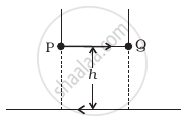Advertisements
Advertisements
प्रश्न
A charged particle would continue to move with a constant velocity in a region wherein ______.
- E = 0, B ≠ 0.
- E ≠ 0, B ≠ 0.
- E ≠ 0, B = 0.
- E = 0, B = 0.
विकल्प
a and c
b and d
a, b and d
c and d
उत्तर
a, b and d
Explanation:
This problem is based upon the single moving charge placed with some uniform electric and magnetic fields in space. Then they experience a force called Lorentz force is given by the relation Fnet = qE + q(v × B).
Force experience by the charged particle due to electric field Fe = qE
Force experience by the charged particle due to magnetic field, Fm = q(v × B)
According to the problem, particle is moving with constant velocity means the acceleration of particle is zero and also it is not changing its direction of motion.
This will happen when the net force on particle is zero.
- if E = 0, and v || B, then Fnet = 0.
- if E ≠ 0, B ≠ 0 and E, v and B are mutually perpendicular.
- When both E and B are absent.
APPEARS IN
संबंधित प्रश्न
A long straight wire carries a current of 35 A. What is the magnitude of the field B at a point 20 cm from the wire?
The net charge in a current-carrying wire is zero. Then, why does a magnetic field exert a force on it?
A straight horizontal wire of mass 10 mg and length 1.0 m carries a current of 2.0 A. What minimum magnetic field B should be applied in the region, so that the magnetic force on the wire may balance its weight?
A conductor has three segments; two straights of length L and a semicircular with radius R. It carries a current I What is the magnetic field B at point P?

For a circular coil of radius R and N turns carrying current I, the magnitude of the magnetic field at a point on its axis at a distance x from its centre is given by,
B = `(μ_0"IR"^2"N")/(2("x"^2 + "R"^2)^(3/2))`
(a) Show that this reduces to the familiar result for field at the centre of the coil.
(b) Consider two parallel co-axial circular coils of equal radius R, and number of turns N, carrying equal currents in the same direction, and separated by a distance R. Show that the field on the axis around the mid-point between the coils is uniform over a distance that is small as compared to R, and is given by, B = `0.72 (μ_0"NI")/"R"` approximately.
[Such an arrangement to produce a nearly uniform magnetic field over a small region is known as Helmholtz coils.]
Correct unit of magnetic field is ______.
In the product
`overset(->)("F") = "q"(overset(->)(υ) xx overset(->)("B"))`
= `"q"overset(->)(υ) xx ("B"overset(^)("i") + "B" overset(^)("j") + "B"_0overset(^)("k"))`
For q = 1 and `overset(->)(υ) = 2overset(^)("i") + 4overset(^)("j") + 6overset(^)("k")` and
`overset(->)("F") = 4overset(^)("i") - 20overset(^)("j") + 12overset(^)("k")`
What will be the complete expression for `overset(->)("B")`?
Two charged particles traverse identical helical paths in a completely opposite sense in a uniform magnetic field B = B0k̂.
A charged particle of charge e and mass m is moving in an electric field E and magnetic field B. Construct dimensionless quantities and quantities of dimension [T]–1.
A long straight wire carrying current of 25 A rests on a table as shown in figure. Another wire PQ of length 1 m, mass 2.5 g carries the same current but in the opposite direction. The wire PQ is free to slide up and down. To what height will PQ rise?

